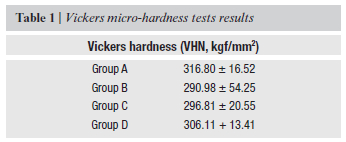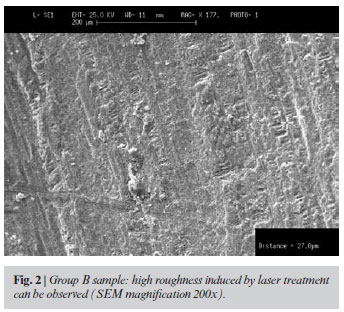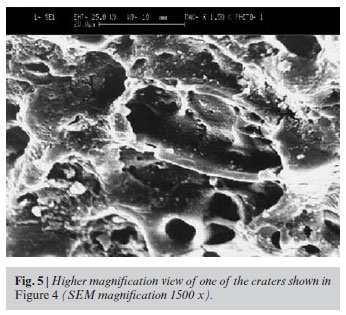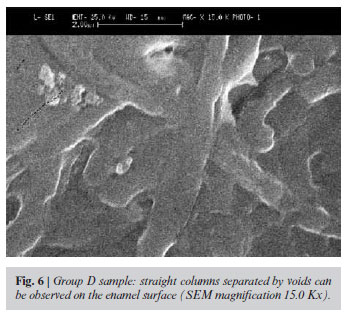RESEARCH AND METHODOLOGIES
Microhardness and morphological changes induced by Nd: Yag laser on dental enamel: an in vitro study
Variazioni della micro durezza variazioni morfologiche indotte dal laser Nd: YAG sullo smalto dentale: uno studio in vitro
Rossella BediniI; Licia ManzonII; Giovanni FrattoII; Raffaella PecciI
IDipartimento di Tecnologie e Salute, Istituto Superiore di Sanità, Rome Italy
IIDipartimento di Scienze dell'Invecchiamento, Università Sapienza, Rome, Italy
SUMMARY
The aim of this work was a scanning electron microscopy (SEM) evaluation of the hardness and morphological changes of enamel irradiated by neodymium: yttrium aluminium garnet (Nd:YAG) laser with different energy levels. Twenty-eight human teeth samples were divided into 4 groups: control, where enamel surface was not lased, and 3 test treated with 3 different levels of energy power 0.6, 1.2 and 2.4 Watt, respectively. In each group, 5 samples underwent Vickers microhardness test and 2 samples were processed for SEM. No significant differences between treated and non treated samples were found by micro-hardness test. However, by SEM, test samples showed a rougher enamel surface than control. Specifically, the 0.6 Watt treated samples showed vertical scratches and glass-like areas, while in the other 2 groups enamel surface was covered by craters and cracks. These findings suggest that enamel should be lased at a low energy level to preserve its integrity and reduce demineralization, and thus for dental caries prevention purposes; while high energy level creates a retentive surface suitable for sealant or composite anchorage.
Key words: energy power, micro-hardness, Nd:YAG laser, microscopy, electron, scanning.
RIASSUNTO
Lo scopo di questo lavoro è stato quello di valutare al microscopio elettronico la durezza e le variazioni morfologiche dello smalto dentale irraggiato con laser Nd: YAG a differenti livelli di potenza. Ventotto campioni di dente umano sono stati suddivisi in quattro gruppi: il controllo, dove la superficie dello smalto non è stata sottoposta all'irraggiamento laser, e gli altri tre gruppi di test sono stati irraggiati con tre diversi livelli di potenza, rispettivamente 0,6, 1,2 and 2,4 Watt. In ogni gruppo, cinque campioni sono stati sottoposti al test di durezza Veckers e due sono stati utilizzati per le osservazioni al SEM. Differenze non significative al test di durezza sono state trovate tra i campioni non trattati e quelli trattati. Al contrario, alle osservazioni al SEM i campioni test mostrano una rugosità maggiore della superficie di quelli del controllo. In particolare i campioni trattati a 0,6 Watt mostrano solchi verticali ed aree vetrificate, mentre negli altri due gruppi la superficie dello smalto appare coperta di crateri e rotture. Queste osservazioni suggeriscono che lo smalto dovrebbe essere trattato con laser a bassa energia per preservare la sua integrità e ridurre la demineralizzazione, ed anche per la prevenzione della carie; mentre l'irraggiamento ad alte energie crea delle superfici di ritenzione adeguate per l'incollaggio e l'adesione di compositi.
Parole chiave: livello di potenza, microdurezza, laser Nd:YAG, microscopia elettrica a scansione.
INTRODUCTION
Dental caries is still a worldwide problem. In a study which compared caries experience and periodontal status between two US populations that lived a century apart it was found that periodontal health has improved since this population resided, over 150 years ago; while Americans between the ages of 16 and 39 appeared to have the same prevalence of caries as a group of individuals that lived 150 years ago [1].
Nowadays, sealing materials are gaining wide acceptance in the scientific community, though they still present some disadvantages: contamination of the operation field, possibility of a non uniform and effective etching, contraction during polymerisation [2]. These issues have led researchers to investigate alternative solutions (i.e. new technologies) in order to overcome these limits. Recently, laser has been employed for the treatment of dental enamel surface. Scientific literature shows that laser treatment on enamel make it more resistant to demineralisation and caries [3-8] by changing its morphology through a melting and re-crystallizing process. Anderson JR and colleagues [9] found that laser irradiation of teeth caused a 15% reduction of demineralisation compared to control group, and of 25% adding acidulated phosphate fluoride (APF) treatment [10].
Huang GF, et al. obtained, a 43% inhibition of in vitro induced carious damages on the fissures and an 80% reduction of the damages occurred on the smooth surfaces of the tooth, using Nd:AG laser and fluorine varnish treatment when compared to control group. Moreover, it has been demonstrated that a higher resistance to demineralisation and caries could be achieved by combining the use of laser to APF treatment or fluorine varnishes [11].
The real phenomenon that causes this effect is related to the chemical-physical changes induced on enamel by laser. The irradiated enamel surface is subjected to water loss between 80 and 120 ºC, to decomposition of the small quantity of organic substance at 350 ºC, to initial loss of carbonate hydroxyapatite between 400 -660 ºC, and to enamel melting at more than 800 -1000 ºC [12]. The high temperatures reached in the superficial layers of the irradiated areas of the tooth cause the melting of the enamel, which then re-crystallizes forming hydroxyapatite crystals larger than the initial ones [12, 13]. This phenomenon could cause a reduction of permeability, a lower penetration of acid inside the underneath layers, and prominent chemical and mineral content changes [14]. Indeed, during the heating and melting process hydroxyapatite [4, 14-16] looses carbonate, up to a complete loss, becoming more resistant to demineralisation. Caries starts when the acids produced by dental plaque diffuse inside tooth through carbohydrates metabolism, dissolving the mineral component. Acid solubility is high for carbonate-apatite, lower for hydroxyapatite and even lower for fluorine-apatite. During laser irradiation, the mineral phase of enamel changes into an initial phase similar, but less soluble, to hydroxyapatite. The loss of carbonate, that decreases from the surface to the internal layers, is caused by the heat produced by laser ray. A 30% of the carbonate is lost between 400 and 600 ºC and it is completely removed only after repeated irradiation beyond the melting temperature of the enamel itself (more than 800 ºC). The complete removal of the carbonate derives both from the absorption depth of the surface and from pulse intensity and duration [15]. According to Tagomori et al. [14], the irradiated enamel surfaces may show different morphologic features, always with an higher roughness in comparison with the not treated ones, whose shape is related to radiation intensity. By increasing radiation intensity can be seen cracks, glazed surfaces and columns separated by voids. Every surface alteration derives from the melting and the subsequent re-crystallisation of the enamel during cooling. The authors also noticed that the observed alterations took place only in the enamel superficial layers. By observing the tooth in a section perpendicular to the surface, it could be noticed not altered enamel crystals in the internal side of the tooth, fused crystals in the intermediate area and hexagonal hydroxyapatite columns, separated by voids and micro cracks in the external side [15].
The aim of this study was to evaluate the morphological and hardness variations of the enamel irradiated by neodymium:yttrium aluminium garnet (Nd: YAG) laser using different radiating energy levels.
MATERIALS AND METHODS
Twenty-eight human teeth, extracted for orthodontic and periodontal reasons were analyzed in this study. The samples were kept in physiologic solution prior to treatment, and then they were divided into 4 groups:
- group A: control group, no treated;
- group B: lased with 60 mJ energy, 10 Hz frequency and 0.6 W power;
- group C: lased with 120 mJ energy, 10 Hz frequency and 1.2 W power;
- group D: lased with 160 mJ energy, 15 Hz frequency and 2.4 W power.
In groups B, C and D enamel was irradiated for 20 s by Nd:YAG laser PulseMaster 600 IQ (American Dental Technologies, Corpus Christi, TX, Texas), with a 1064 nm wave length, a 10 µs pulse duration, and an optic fibres transmission system. Irradiation has been conducted by an optic fibres probe, with a 200 µm diameter, directed perpendicular to the enamel surface of the teeth. The irradiated surface was, in each case, about 5x5 mm2 wide. Each group was constituted by 7 teeth. Five samples per group underwent to Vickers micro-hardness test using a FM 700 (Future Tech) (Figure 1) micro-hardness tester under a 300 gf load applied for 15 s, in order to evaluate the variations of surface hardness, eventually caused by laser treatment at different energy intensities. Teeth surfaces have not been intentionally subjected to lapping to avoid reduction of enamel thickness (typically 1-1.5 mm). Indeed, the measured hardness values are considered as reliable if the enamel minimal thickness is not 1.5 times lower than the average diagonal length of the hardness impression produced on the sample. In the present study hardness impressions having 4045 µm diagonal were obtained, applying a 300 gf load: the measured value can be considered as not influenced by underneath dentine hardness. All the hardness impressions that presented the two diagonals more than 15% different in length have been excluded from the results.

The two remaining teeth of each group were analyzed by scanning electron microscopy (SEM) at different magnifications in order to observe morphological changes induced by irradiation of enamel surface. The specimens were coated with a 25 nm layer of gold by vacuum evaporation Emitech K 550 (Emitech, Ashford, Kent, UK) and placed on the storage of a SEM (LEO 435 Vp, LEO Electron Microscopy Ltd, Cambridge, UK) for evaluation.
As for the satistical analysis, results of Vickers micro-hardness tests were analyzed by ANOVA. Results are presented as mean ± standard deviations, and differences at p < 0.05 were considered statistically significant.
RESULTS
The results of the micro-hardness tests are shown in Table 1. No statistically significant differences between test groups and control were found. SEM observation showed that group B enamel samples had a similar morphological pattern. The enamel surface appeared ploughed by long and regular vertical scratches, which made the surface rougher (Figure 2). The scratches were probably due to the sliding of optic fibre on the sample surface. The increase of roughness could be clearly observed in Figure 3, where the enamel surface appeared glazed. In Group C glazed areas, cracks and craters could be observed (Figure 4). Specifically, the irradiated enamel surface appeared mostly covered with craters (Figure 5), probably due to an increase of temperature up to the sublimation point of the material that, during the subsequent solidification, completely changed its initial structure.





Group D samples (Figure 6) showed a morphology completely different from control (Figure 7). Laser treatment produced a remarkable change of enamel prisms: it altered their original shape, size and arrangement. Thus, enamel prisms took on a variable shape, they became larger, and assumed an irregular arrangement. The melting and the following solidification process of the enamel produced a morphology characterized by columns separated by voids.


DISCUSSION
Hard tissue modification by means of laser irradiation is becoming popular in dentistry [17]. Efforts have specifically been concentrated on new laser-based biomedical techniques for painless, contact-free, hard dental tissue interventions [18]. Laser has been also proposed for preventive treatment, diagnosis of caries, etching of enamel, caries removal, to debond ceramic brackets [19], and, more recently, to enlarge the root canal during the endodontic therapy [18].
Attention should be paid to several issues concerning safety and efficacy of the lasing procedures. Indeed, the laser beam has the potential to penetrate through the tooth tissues and to affect the underlying pulpal tissue as well. Both thermal and mechanical effects of the interaction are definitely influenced by the nature of the tissue target and the laser pulse characteristics [20].
In the literature there are conflicting evidences on the effects of laser treatment on enamel structure; this is most probably due to the high number of variables involved in the lasing process: power, pulse frequency and duration of irradiation [21]. Therefore, the choice of the laser parameters for various applications is crucial.
In the present study those parameters have been clearly defined. Group B samples showed a glazed surface where micro-cracks were not present. Therefore, according to our analysis, it can be suggested the use of laser with these irradiation parameters for caries prevention, since the morphology produced by this treatment makes enamel more resistant to caries due to the maintenance of the original surface hardness characteristics.
Group C samples surfaces showed deep alterations of the enamel structure presenting cracks, glazed areas and many craters. Group D samples, treated with higher energy, showed long straight columns separated by voids. These heterogeneous structures were probably related to the not uniform intensities produced on the surface between the central and the peripheral areas of the laser ray. For this reason, in the peripheral areas structures that have been detected in lower energy irradiated areas were present and in the central areas craters, expressions of a more stressed enamel surface, were detected. Taken together these results suggests that high energy laser treatment could be used for conservative dentistry since it creates a retentive surface suitable for sealants or composites anchorage.
Previous studies revealed that both Nd:YAG and Er:YAG lasers could be an alternative tool for enhancing deciduous enamel acid resistance [21]. Laser usage in dental hard tissues as well as in carious lesions resulted in effective ablation without thermal injury to the surrounding hard tissues such as carbonization or crack formation [22]. Similar results were also reported with different pulse parameters of Nd:YAG lasers. Investigators studying the ablation efficiency, thermal damage and surface characteristics of dentine irradiated with a nanosecond Nd: AG laser found that the surface of the dentine had a glazed appearance with crack formation when an energy of 80 mJ/pulse at a 10 Hz pulse repetition rate was used [23]. The macroscopic inspection of the ablated dentine with picosecond pulses of an Nd:YAG laser showed smoothed craters, free of thermal damage but with the presence of cracks in some cases [20]. Successful ablation of dentine was observed, with removal of the smear layer and debris, with opened orifices in the case of 1064 nm pulses [20].
These evidences suggest that greater efforts should be concentrated on the studying of laser efficacy for the treatment of dental cavity and in particular papers investigating the role of laser parameter are needed in order to better take advantage of laser potential and to tailor its usage to achieve the desired clinical outcome.
Conflict of interest statement
There are no potential conflicts of interest or any financial or personal relationships with other people or organizations that could inappropriately bias conduct and findings of this study.
REFERENCES
1. Rose EK, Vieira AR. Caries and periodontal disease: insights from two US populations living a century apart. Oral Health Prev Dent 2008;6:23-8.
2. Ardu S, Perroud R, Krejci I. Extended sealing of interproximal caries lesions. Quintessence Int 2006;37:423-7.
3. Featherstone JD, Barret-Vespone NA, Fried D, Kantorowitz Z, Seka W. CO2 laser inhibitor of artificial caries-like lesion progression in dental enamel. J Dent Res 1998;77:1397-403.
4. Featherstone JD. Caries detection and prevention with laser energy. Dent Clin North Am 2000;44:955-69.
5. Hossain M, Nakamura Y, Kimura Y, Yamada Y, Kawanaka T, Matsumoto K. Effect of pulsed Nd:YAG laser irradiation on acid demineralisation of enamel and dentin. J Clin Laser Med Surg 2001;19:105-8.
6. Hossain M, Kimura Y, Nakamura Y, Yamada Y, Kinoshita JI, Matsumoto K. A study on acquired acid resistance of enamel and dentin irradiated by Er, Cr:YSGG laser. J Clin Laser Med Surg 2001:19:159-63.
7. Hsu CY, Jordan TH, Dederich DN, Wefel JS. Effects of lowenergy CO2 laser irradiation on the organic matrix on inhibition of enamel demineralisation. J Dent Res 2000;79:1725-30.
8. Nelson DG, Wefel JS, Jongebloed WL, Featherstone JD. Morphology, histology and crystallography of human dental enamel treated with pulsed low-energy infrared laser irradiation. Caries Res 1987;21:411-26.
9. Anderson JR, Ellis RW, Blankenau RJ, Beiraghi SM, Westerman GH. Caries resistance in enamel by laser irradiation and topical fluoride treatment. J Clin Laser Surg 2000;18:33-9.
10. Harazaki M, Hayakawa K, Fukui T, Isshiki Y, Powell LG. The Nd-YAG laser is useful in prevention of dental caries during orthodontic treatment. Bull Tokyo Dent Coll 2001;42:79-86.
11. Haider SM, White GE, Rich A. Combined effects of argon laser irradiation and fluoride treatments in prevention of caries-like lesion formation in enamel: an in vitro study. J Clin Pediatr Dent 1999;23:247-57.
12. Rohanizadeh R, LeGeros RZ, Fan D, Jean A, Daculsi G. Ultrastructural properties of laser irradiated and heat-treated dentin. J Dent Res 1999;78:1829-35.
13. Ferreira JM, Palmera J, Phakey PP, Rachinger WA, Orams HJ. Effects of continuous-wave CO2 laser on the ultrastructure of Human dental enamel. Arch Oral Biol 1989;34:551-62.
14. Tagomori S, Iwase T. Ultrastructural change of enamel exposed to a normal pulsed Nd-YAG Laser. Caries Res 1995;29:513-20.
15. Márquez F, Quintana E, Roca I, Salgado J. Physical-mechanical effects of Nd:YAG laser on the surface of sound dental enamel. Biomaterials 1993;14:313-6.
16. Huang GF, Lan WH, Guo MK, Chiang CP. Synergystic effect of Nd:YAG laser combined with fluoride varnish on inhibition of caries formation in dental pits and fissures in vitro. J Formos Med Assoc 2001;100:181-5.
17. Franke M, Taylor AW, Lago A, Fredel MC. Influence of Nd: YAG laser irradiation on an adhesive restorative procedure. Oper Dent 2006;31:604-9.
18. Khabbaz MG, Makropoulou MI, Serafetinides AA, Papadopoulos D, Papagiakoumou E. Q-Switched vs. freerunning Er:YAG laser efficacy on the root canal walls of human teeth: a SEM study. J Endod 2004;30:585-8.
19. Hayakawa K. Nd:YAG laser for debonding ceramic orthodontic brackets. Am J Orthod Dentofacial Orthop 2005;128:638-47.
20. Dayem RN. Evaluation of the ablation efficacy and morphology of some hard tissues irradiated with different types and modes of laser. Lasers Med Sci Oct 2007. [Epub ahead of print] .
21. Castellan CS, Luiz AC, Bezinelli LM, Lopes RM, Mendes FM, De P Eduardo C, De Freitas PM. In vitro evaluation of enamel demineralization after Er:YAG and Nd:YAG laser irradiation on primary teeth. Photomed Laser Surg 2007; 25:85-90.
22. Geraldo-Martins VR, Robles FR, Matos AB. Chlorhexidine's effect on sealing ability of composite restorations following Er:YAG laser cavity preparation. J Contemp Dent Pract 2007;8:26-33.
23. Shariati S, Pogrel MA, Marshall GW Jr, White JM. . Structural changes in dentin induced by high energy, continuous wave carbon dioxide laser. Lasers Surg Med 1993;13:543-7.
 Address for correspondence:
Address for correspondence:
Rossella Bedini
Dipartimento di Tecnologie e Salute, Istituto Superiore di Sanità
Viale Regina Elena 299
00161 Rome, Italy
E-mail: rossella.bedini@iss.it
Received on 1 March 2010.
Accepted on 8 April 2010.
